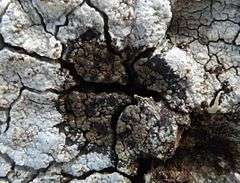Rimularia
Rimularia is a genus of lichenized fungi in the family Agyriaceae. The genus is widely distributed, especially in temperate areas, and according to a 2008 estimate, contains 13 species.[1] Rimularia was circumscribed by Finnish botanist William Nylander in 1868.[2]
| Rimularia | |
|---|---|
 | |
| Rimularia insularis | |
| Scientific classification | |
| Kingdom: | |
| Division: | |
| Class: | |
| Order: | |
| Family: | |
| Genus: | Rimularia Nyl. (1868) |
| Type species | |
| Rimularia limborina Nyl. (1868) | |
Species
- R. actinostoma
- R. applanata
- R. australis
- R. austrolimborina
- R. badioatra
- R. exigua
- R. furvella
- R. fuscosora
- R. gibbosa
- R. globulispora
- R. globulosa
- R. gyrizans
- R. gyromuscosa
- R. hensseniae
- R. impavida
- R. insularis
- R. intercedens
- R. limborina
- R. maculata
- R. mullensis
- R. psephota
- R. sphacelata
gollark: #ThatClarifiesItSomewhat
gollark: I mean, you still have to conduct experiments, and there's a lot of stuff to test.
gollark: What's `tachydidaxis` exactly?
gollark: This seems poorly thought out.
gollark: Okay, one of the jailbreaks (for firmware 5.6.5) is actually triggerable from just viewing an HTML page. This is worrying.
References
- Kirk PM, Cannon PF, Minter DW, Stalpers JA (2008). Dictionary of the Fungi (10th ed.). Wallingford, UK: CAB International. p. 604. ISBN 978-0-85199-826-8.
- Nylander W. (1868). "Addenda nova ad lichenographiam Europaeam. Contin. IX". Flora (Regensburg) (in Latin). 51: 473–8.
This article is issued from Wikipedia. The text is licensed under Creative Commons - Attribution - Sharealike. Additional terms may apply for the media files.